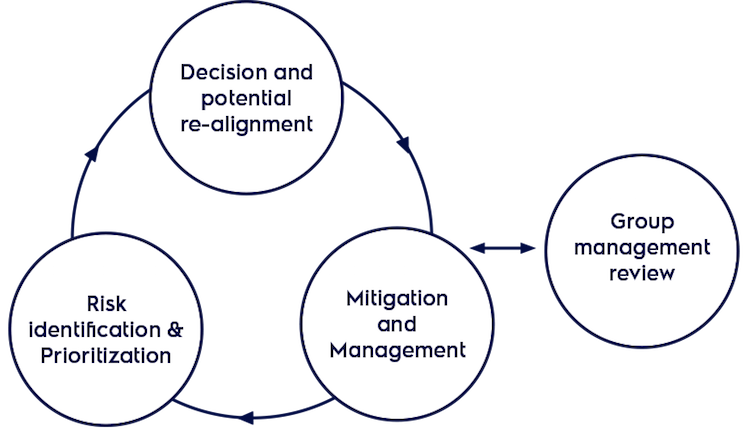A 360o analysis of risk requires insights from Group Management, the function level and local facilities. That’s why identifying and addressing non-financial risks is a cross-functional responsibility.
At Electrolux, a future focus enables us to pinpoint and prepare for a changing business landscape. The emergence of a global middle class, the growth of megacities, the urgency of climate change, chemical pollutants, access to water, energy and raw materials and breakthrough technologies will all impact the way we do business, and how we are perceived as a company. Understanding and managing the non-financial risks and opportunities associated with these macro drivers is an integrated part of managing our business.

As we increase our understanding of how our business impacts human rights, we are putting in place the tools to mitigate and remedy them.
Our impact assessments include a risk analysis of human rights, completed most recently in 2013. In our analyses, we map operations at risk for specific issues using tools such as Verisk Maplecroft, Freedom House for civil and political rights, Human Development Index, (World Bank). Transparency International’s Corruption Perception Index and WWF Water Risk Assessment for water risks.
Tackling many of the issues that emerge from our analysis starts at the local level, with each facility and supplier located in regions we deem as high and medium risk. Our classification is adjusted every year, taking into account the facility’s location and past performance, as well as the number of employees, types of activities, Ethics Helpline records and customer requests. This forms the basis for where we conduct audits. Operations in Latin America, China and Egypt were the focus of audits in 2015.
Human rights screening is part of acquiring new operations. This was the case in the purchase of a new Professional manufacturing site in China this year.
| Right | Issue(s) | Value chain | Context |
|---|---|---|---|
| Freedom of association | Industrial relations |
Own units Suppliers |
We have operations and suppliers located in countries where this right is restricted and where effective labor/management dialogue is in its infancy. |
| Conditions at work |
Health & safety Working hours |
Own units Suppliers |
Audit findings from both suppliers and our own units continue to indicate room for improvement. Both issues are complex and require constant follow up. |
|
Right to education Protection of the family Children's rights |
Minimum age | Suppliers | Risks relate to non-compliance to requirements on working conditions for authorized minors (age 16-18), inadequate procedures to determine age at time of hiring, and occasional findings of children below minimum working age. |
| Right to adequate standards of living | Compensation |
Own units Suppliers |
With operations in low-cost countries, the risks that salary levels do not cover costs for the workers to be able to provide for themselves and their families increases. |
|
Right to life Right to liberty |
Security arrangements Conflict minerals |
Own units Suppliers |
Security providers need to meet high standards to ensure their practices do not raise risks for human rights infringements. We need to ensure that our procurement of certain minerals do not finance human-rights violations. |
|
Non-discrimination Gender equality |
Diversity & non-discrimination |
Own units Suppliers |
The largest improvement potential here lies in the area of gender diversity. |
Based on a long list of potential impacts incurring from our activities, we have identified the above human rights risks as most relevant – or salient – to managing in our operations. This current assessment takes into account:
We monitor performance of these issues through a combination of our Ethics Helpline, management-labor dialogue, health and safety committees, local grievance mechanisms and the Code of Conduct mailbox for suppliers. Employee interviews are also included in our audits, which help capture important issues. We address our findings through local corrective action plans and overall performance is reported to business sectors. We will further develop our approach to identifying and managing these issues in 2016, including Group level and local risk assessments.
A number of Group functions are accountable for both identifying and managing non-financial risks in their area of responsibility. These risks are reported on to Group Management regularly and are also fed into our materiality process. Our approach is outlined further in the Annual report.
| Drivers | What this means for us | |
|---|---|---|
| People |
The global middle class An aging population |
|
| Access to resources |
Energy Water |
|
| Environment |
Climate change Chemicals pollutants |
|
| Technology |
Accelerating technology change |
|